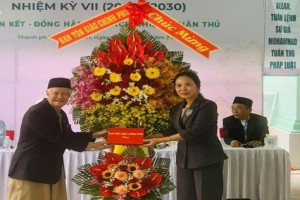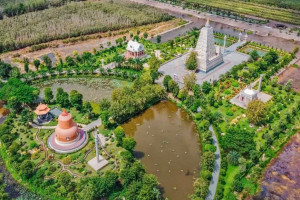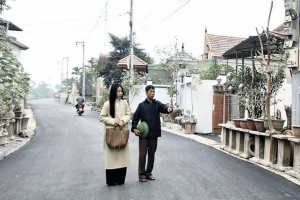
On August 2, 1955, upon request by the Interior Department under the Government Office and approval by the Government Council, the Prime Minister of Vietnam issued the Decree No 566-TTg on the establishment of the Committee for Religious Affairs under the Government Office – the initial body of Vietnam’s current Government Committee for Religious Affairs.
The 60-year development process of the central government agency on religious affairs has been closely attached to the making of proposals on and implementation of Vietnam Party and State’s undertakings and policies on religious affairs in the cause of national struggle for independence earlier and national construction and defense recently, marked with important milestones in different stages.
In the 1955-1975 period, the central Committee for Religious Affairs performed functions helping the Government Office to implement guidelines and policies on religious affairs, especially the Order No 234/SL dated June 14, 1955 by President Hồ Chí Minh on religious affairs.
In this period, the Central Committee for Religious Affairs liaised directly with religious organizations in order to encourage religious followers and dignitaries to proactively participate in the cause of the national construction in the North, and the struggle against US-backed Sai Gon regime in the South for the implementation of the Geneva Agreement, especially the fight against a plot to coerce Catholic countrymen into migrating to the South.
Also in this period, religious organizations, such as the Mobilizing Committee for Cao Dai Unity, Vietnam Buddhist Unified Association, Vietnam Evangelical Church (Northern), Vietnam Unified Buddhist Church, First and Second Cao Dai Alliance … were established, making important contributions in gathering and encouraging religious dignitaries and followers to join patriotic movements and support the struggle against American intervention for national unification.
In the 1975-1990 period, the Government’s Committee for Religious Affairs performed functions and tasks so as to assist the Chairman of the Council of Ministers with the state governance on religious affairs when the country was briefly reunified. The Government’s Committee for Religious Affairs proposed to the Prime Minister the issuance of Resolution 297/CP on religious affairs. At the same time, the Government’s Committee for Religious Affairs provided guidance for several religious organizations to strengthen their unified organizations and build religious charters and action orientations for “Better secular and religious life”, close attachment to the nation. Specifically, the Catholic Bishops’ Conference of Vietnam was established, with the motto “Living the Gospel within the nation”; the Vietnam Buddhist Sangha was founded, with the motto for action “Dharma – Nation – Socialism”…
From 1990 to presence, as the country entered a comprehensive phase of innovation in all social, cultural, economic… fields, the Government’s Committee for Religious Affairs carried out its function of advising the Party and State on the religious policies, which resulted in the issuance of a resolution in 1990 on strengthening the state governance on religious affairs in the new situation. This resolution has clearly recognized the religious need of certain groups of people, and positive values of religious ethics. The resolution, at the same time, specifically pointed out responsibilities of concerning state sectors and administrative levels in the guarantee of religious freedom for religious people. This is one of most important milestones in the innovation of religious policies and the state governance on religious affairs in Vietnam. It can be said that the innovation in the way of thinking and understanding of belief and religion is one of the most important innovations in the reform and renewal process in Vietnam under the Vietnamese Communist Party.
In early 21 century, given contexts of many changes in the world, the country’s international integration and many emerging issues in the religious life in the country, the Government Committee for Religious Affairs in collaboration with concerning agencies proposed to the 9th Central Party Committee the approval of a resolution known as Resolution No 25 on religious affairs. Resolution 25 stated that belief and religion would co-exist with the nation in the process of building socialism in the country; religious followers form an integral part of the great national unity bloc; the Party and State consistently implement the policy of great national and religious unity: unity of followers of various religions and unity of religious and non-religious people. The resolution created a fundamental change in the understanding of religion, leading to favorable conditions for religious activities by religious followers and encouragement of religious followers to make contributions to national construction and defense.
To institutionalize the Party’s undertakings on belief and religion for meeting people’s religious needs as well as ensuring efficiency in the state governance on religious affairs, the Standing Committee of the 9th National Assembly enacted the Ordinance on Belief and Religion in June 2004.
The Ordinance on Belief and Religion and its guiding decrees have not only demonstrated the consistent policy of the Party and State of Vietnam on ensuring people’s right to freedom of belief and religion and meeting rapidly changing religious needs in the country, but also conformed to international covenants on human rights.
The Ordinance on Belief and Religion proved to be practically significant for religious people in realizing their religious freedom and for efficiency of the state administration on religious affairs. It’s not only the highest legal document on religion ever enacted by 2004, but also the most specific legal framework for religious activities. For examples, the ordinance has provided specific provisions for registration and recognition of religious organizations, international relations by religious organizations, religious activities by foreign nationals in Vietnam, respect of international laws on religion in Vietnam…
From 1990 to 2015, 36 religious organizations of Protestantism, Islam, Bahai’i, Caodaism, Hoa Hao Buddhism, Buu Son Ky Huong, Tu An Hieu Nghia, Brahmanism, Minh Su and Minh Ly faiths have been registered and recognized by State authorities. Also in this period, many international religious events were hosted by Vietnam’s religious organizations, including the UN Day of Vesak (2008 and 2014), General Assembly of the Federation of Asian Bishops' Conferences (FABC)…
Since 2005 the Government Committee for Religious Affairs has guided localities and Protestant organizations to implement the Directive No 01 on some tasks regarding Protestantism issued by Vietnam’s Prime Minister on February 4, 2005, and closely worked with concerning state agencies for bringing Protestant practices in the Central Highlands into a normal basis, and step by step guiding Protestant activities by Mong ethnics in Northern mountainous provinces to stability.
Currently, approximately 95% of the country population practices certain forms of belief, with about 25 million followers of religions, accounting for about 27% the population.
Tri An




